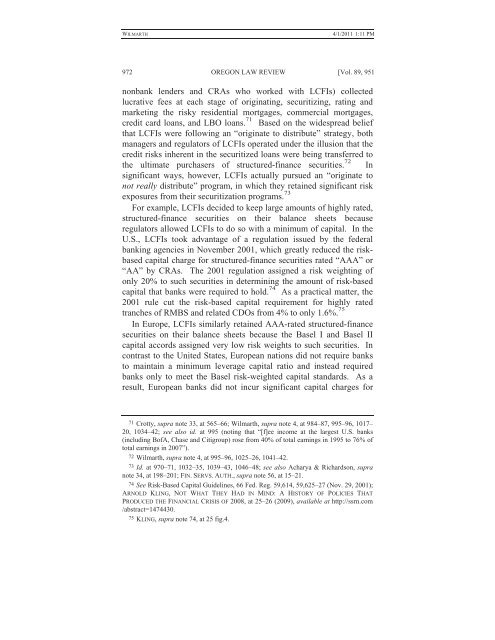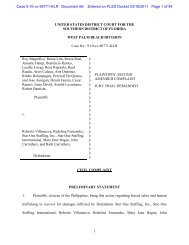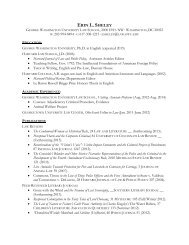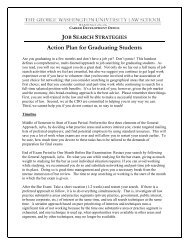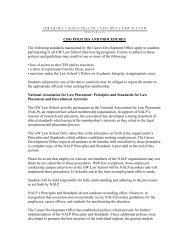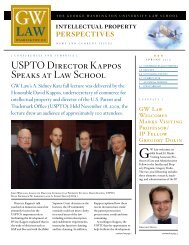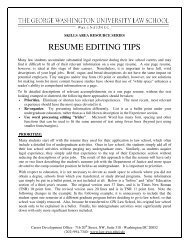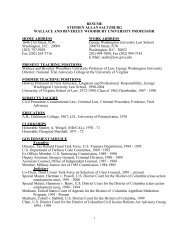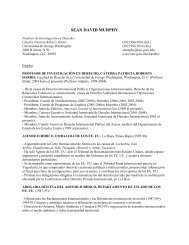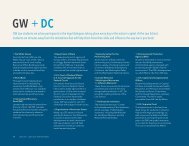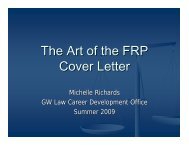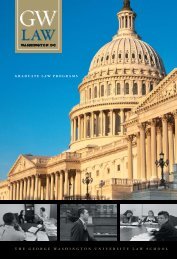CLE Materials for Panel #1 - George Washington University Law ...
CLE Materials for Panel #1 - George Washington University Law ...
CLE Materials for Panel #1 - George Washington University Law ...
You also want an ePaper? Increase the reach of your titles
YUMPU automatically turns print PDFs into web optimized ePapers that Google loves.
WILMARTH<br />
4/1/2011 1:11 PM<br />
972 OREGON LAW REVIEW [Vol. 89, 951<br />
nonbank lenders and CRAs who worked with LCFIs) collected<br />
lucrative fees at each stage of originating, securitizing, rating and<br />
marketing the risky residential mortgages, commercial mortgages,<br />
credit card loans, and LBO loans. 71 Based on the widespread belief<br />
that LCFIs were following an “originate to distribute” strategy, both<br />
managers and regulators of LCFIs operated under the illusion that the<br />
credit risks inherent in the securitized loans were being transferred to<br />
the ultimate purchasers of structured-finance securities. 72 In<br />
significant ways, however, LCFIs actually pursued an “originate to<br />
not really distribute” program, in which they retained significant risk<br />
exposures from their securitization programs. 73<br />
For example, LCFIs decided to keep large amounts of highly rated,<br />
structured-finance securities on their balance sheets because<br />
regulators allowed LCFIs to do so with a minimum of capital. In the<br />
U.S., LCFIs took advantage of a regulation issued by the federal<br />
banking agencies in November 2001, which greatly reduced the riskbased<br />
capital charge <strong>for</strong> structured-finance securities rated “AAA” or<br />
“AA” by CRAs. The 2001 regulation assigned a risk weighting of<br />
only 20% to such securities in determining the amount of risk-based<br />
capital that banks were required to hold. 74 As a practical matter, the<br />
2001 rule cut the risk-based capital requirement <strong>for</strong> highly rated<br />
tranches of RMBS and related CDOs from 4% to only 1.6%. 75<br />
In Europe, LCFIs similarly retained AAA-rated structured-finance<br />
securities on their balance sheets because the Basel I and Basel II<br />
capital accords assigned very low risk weights to such securities. In<br />
contrast to the United States, European nations did not require banks<br />
to maintain a minimum leverage capital ratio and instead required<br />
banks only to meet the Basel risk-weighted capital standards. As a<br />
result, European banks did not incur significant capital charges <strong>for</strong><br />
71 Crotty, supra note 33, at 565–66; Wilmarth, supra note 4, at 984–87, 995–96, 1017–<br />
20, 1034–42; see also id. at 995 (noting that “[f]ee income at the largest U.S. banks<br />
(including BofA, Chase and Citigroup) rose from 40% of total earnings in 1995 to 76% of<br />
total earnings in 2007”).<br />
72 Wilmarth, supra note 4, at 995–96, 1025–26, 1041–42.<br />
73 Id. at 970–71, 1032–35, 1039–43, 1046–48; see also Acharya & Richardson, supra<br />
note 34, at 198–201; FIN.SERVS.AUTH., supra note 56, at 15–21.<br />
74 See Risk-Based Capital Guidelines, 66 Fed. Reg. 59,614, 59,625–27 (Nov. 29, 2001);<br />
ARNOLD KLING, NOT WHAT THEY HAD IN MIND: A HISTORY OF POLICIES THAT<br />
PRODUCED THE FINANCIAL CRISIS OF 2008, at 25–26 (2009), available at http://ssrn.com<br />
/abstract=1474430.<br />
75 KLING, supra note 74, at 25 fig.4.


